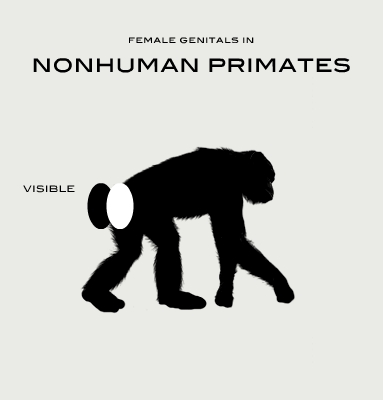October 18, 2007 11:22 PM
Medical Science Monitor, 2006, Vol. 12, No. 5
Inaccessible and concealed external female genitals are one of the morphological characteristics distinguishing humans from other higher primates.

External female sexual organs in subhuman primates are visible and accessible in the habitual quadrupedal and occasional bipedal posture, whereas these organs in the human female are inaccessible and concealed in any posture. A prospective consequence of gradual bipedalism of hominids during evolution was a shifting of the external female genitals in an anterior direction. In the completely bipedal Homo sapiens, this resulted in the vulvo-cryptic phenomenon, i.e. concealed female genitals in humans.
The unique morphology of the human female pelvis served as an obstacle to easy access of the male in the process of copulation, necessitating the female’s conscious decision for sexual intercourse. This circumstance might have created a psychological basis for female propellant psychosexual manipulation of the male as a natural consequence.
The Stripper's Secret, Matthew Hutson, Sept. 2007

Also, through the process of positive selection it could have formed a basis for linking reproductive success with the development of cognitive and emotional capacities. Female consent to copulation is a conscious and complex act that would be Impossible without the involvement of highly developed emotional-cognitive and memoric brain systems.
Thus the extraordinary evolutionary strategy might imply a teleological link between concealed female genitals and the emotional-cognitive characteristics of man, creating a permanent promoter of further development of emotional and cognitive brain systems with an impact on all domains of everyday life.

When apes switched from quadrupedalism to bipedalism, the swollen external female genitals shrunk to the tiny human female labia, went hidden behind the pubic hair and between the legs, and became concealed in any posture (otherwise known as the vulvo-cryptic phenomenon). also, the smells that signal fertility became nearly imperceptible.

Sexual behavior, sexual swelling, and penile evolution in chimpanzees
Archives of Sexual Behavior, Volume 23, Number 3, June 1994
Studies indicate that, aside from its functions as a visual signal, the female chimpanzee’s sexual skin swelling adds considerably to the distance males must negotiate during copulation to place spermatozoa at the cervical os. Evolution of the male’s elongated, filiform penis may therefore be the result of sexual selection, to negotiate the long vagina of the female and to penetrate copulatory plugs deposited during previous copulations.

Why Women Have Breasts
Frances E. Mascia-Lees, Anthropology Now, Vol. 1 No. 1, April 2009
Desmond Morris, a curator of mammals at the London Zoo, suggested that permanently enlarged breasts in human females resulted from hominid bipedalism. (…)
The link between bipedalism and permanent breast enlargement, according to Morris, has to do with the erotic nature of breasts. He argues that as early humans (hominids) began walking upright, face-to-face encounters between the sexes became the norm, affecting the position used in sexual intercourse: males would no longer mount females from behind as they do among non-human primates. In the non-human primate position, presentation of the female buttocks to the male is an erotic display that stimulates male interest and excitement. With the advent of bipedalism, Morris argues, if females were to be successful in shifting male interest around to the front, evolution would have to do something to make the female frontal region more stimulating to males. This was accomplished, Morris says, through self-mimicry in which female breasts came to look like rounded buttocks: female breasts became mimics of “the ancient genital display of the hemispherical buttocks.”
Szalay and Costello (1991) have continued this line of thinking, but argue that permanently enlarged breasts sexually arouse males not because they look like buttocks, but because they mimic the appearance of female genitalia.
